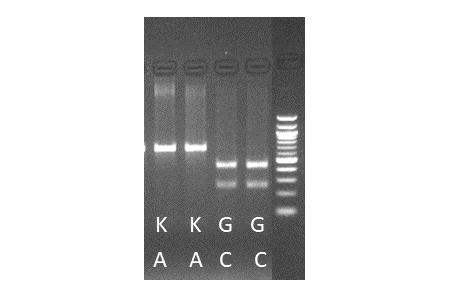Contributed by Priscilla Glenn and Jorge Dubcovsky
There are several known genes in the wheat genome that are associated with increases in spikelet number per spike (SNS), a valuable target for higher yield breeding. However, many of the gene variants affecting SNS are also associated with alterations in flowering time, which in turn can result in yield penalties due to reduced fertility or increased risks of frost or heat damage. Some examples of these genes are the vernalization gene VRN1 (1), photoperiod gene PHOTOPERIOD1 (PPD1) (2), and the FLOWERING LOCUS T1 gene (FT1) (3, 4).
in 2019 Shaw et al (5), working with a mutant population of the tetraploid wheat variety Kronos, reported that loss-of-function mutants in the FLOWERING LOCUS T2 (FT2) were associated with increases in spikelet number per spike (SNS) and, showed limited effects in heading time. More specifically, the loss-of-function variant ft-A2 showed a greater positive effect on SNS than the ft-B2 line. However, ft-A2 was also associated with reduced fertility, calculated as the number of grains per spike divided by the number of florets per spike, which offset gains in total grain yield.
The analysis of natural variation present in exome capture data deposited in the T3 database (https://triticeaetoolbox.org/wheat) revealed the existence of a polymorphism (position 124,173, 909 in chromosome arm 3AS of Chinese Spring, RefSeq v1.0 assembly) (6).
A comparative genomics analysis suggested that D10 is the ancestral allele in the grasses. A germplasm survey showed that the A10 allele is present at very low frequencies in durum wheat and is frequent in common wheat. Among the hexaploid lines, the A10 allele frequency is higer in winter and fall-planted spring varieties. In consequence, the FT-A2 A10 allele could be a valuable resource to increase grain yield in durum wheat and fall-planted common wheat. It is important to note that this A10 allele works better in combination with the H1 allele of the bZIPC1 locus.
The FT-A2 A10 allele in durum wheat was originally found in lines with limited agronomic value. Glenn et al. (6) developed and made available a Kronos line carrying the A10 allele (PI 699107). Kronos is a variety with excellent pasta quality, so it is a better starting point for introgression programs.
Other SNS pages in MASWheat:
- Spikelet number per spike gene bZIPC1
- Spikelet number per spike gene WAPO-A1
- Spikelet number per spike and spike number gene TaCol-B5
CAPS Marker for FT-A2 D10A (6)
Primers
FT-A2-D10A-F 5’- CCGGACAGAGCAATGGACTT -3’
FT-A2-D10A-R 5’- TGAGTAAGCAGTCTAGGAGCAT -3’
PCR and digestion conditions
- Denaturing step: 94 °C for 5 min
- Amplification. 35 cycles:
94 °C 30 s
55 °C 30 s
72 °C 30 s
- Extension step: 72 °C for 5 min
- Digest with ApaI
Expected products
After digestion with the restriction enzyme ApaI, the fragment amplified from the D10 allele is not digested, and the fragment amplified from the A10 allele yields two fragments of 448 and 257 bp.

References
1. Wheat VRN1, FUL2 and FUL3 play critical and redundant roles in spikelet development and spike determinacy. Li C, Lin H, Chen A, Lau M, Jernstedt J, Dubcovsky J. In: Development, 2019, 15;146(14):dev175398. DOI:10.1242/dev.175398
2. Mutant alleles of Photoperiod-1 in wheat (Triticum aestivum L.) that confer a late flowering phenotype in long days. Shaw LM, Turner AS, Herry L, Griffiths S, Laurie DA. Mutant alleles of Photoperiod-1 in wheat (Triticum aestivum L.) that confer a late flowering phenotype in long days. In: PLoS One, 2013, 8(11):e79459. DOI:10.1371/journal.pone.0079459
3. Linkage mapping identifies a non-synonymous mutation in FLOWERING LOCUS T (FT-B1) increasing spikelet number per spike. Brassac J, Muqaddasi QH, Plieske J, Ganal MW, Röder MS. In: Scientific reports, 2021, 11(1):1-2. DOI:10.1038/s41598-020-80473-0
4. QTL mapping for grain yield and three yield components in a population derived from two high-yielding spring wheat cultivars. Isham K, Wang R, Zhao W, Wheeler J, Klassen N, Akhunov E, Chen J. In: Theoretical and Applied Genetics, 2021, 9:1-7. DOI:10.1007/s00122-021-03806-1
5. FLOWERING LOCUS T2 regulates spike development and fertility in temperate cereals. Shaw LM, Lyu B, Turner R, Li C, Chen F, Han X, Fu D, Dubcovsky J. In: Journal of Experimental Botany, 2019, 70:193-204. DOI:10.1093/jxb/ery350
6. Identification and characterization of a natural polymorphism in FT-A2 associated with increased number of grains per spike in wheat. Glenn P, Zhang J, Brown-Guedira G, DeWitt N, Cook JP, Li K, Akhunov E, Dubcovsky J. In: Theoretical and Applied Genetics, 2021, DOI:10.1007/s00122-021-03992-y
